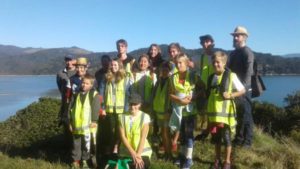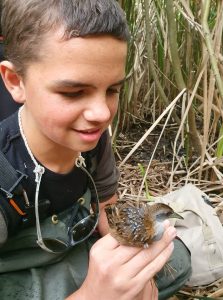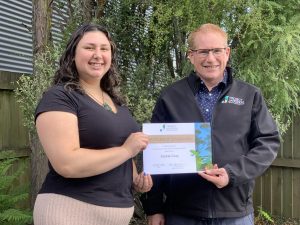The 2023-24 kākā breeding season has finished and the population has continued to grow. With five chicks known to have fledged this year, we are making steady progress towards a sustainable population of these amazing birds in the park.
Kākā don’t usually nest in successive years and the Abel Tasman kākā females had already nested two seasons in a row, so we were pleased that they managed to set three nests this year, although it wasn’t all plain sailing.
Some of the female birds born in the park have transmitters fitted when they fledge so we can keep an eye on them, although the transmitters are designed to stop working and fall off after a couple of years. Two birds with transmitters nested this season, one at Anchorage and one at Bark Bay. We also found a female with an expired transmitter nesting in the same tree as last year, so we were able to protect and monitor three nests.
Unfortunately, one of the nests was lost during the egg stage. The nest was in a horizontal log near the ground and very difficult to protect. We don’t know what caused it to fail, although a rat was seen on a camera nearby. These unfortunate situations remind us why it’s so important to keep controlling predators like rats in the park.
Our Anchorage nest was the star of the season. Kākā usually manage to produce one or two chicks, but this superstar kākā mum fledged four babies – what a champ!
The Bark Bay nest was able to fledge one chick. This mum originally laid five eggs, all of which hatched, but only two chicks survived longer than a week and one of these perished in the nest after we’d banded them. This is unusual, so we are looking into reasons for that which could include overheating in the hot summer or misadventure in the nest. We are pleased that the other chick successfully fledged.
As you can see, re-introducing kākā to the park was just the first step towards our goal of a sustainable breeding population of these birds in the Abel Tasman. In total, we’ve released 35 kākā into the park (23 at Bark Bay), and every season we follow their nesting journeys and do all we can to protect them and enhance their chances of success. Each breeding season has its highs and lows and brings new challenges, but we are making good progress. Since the re-introduction programme began we have seen 31 fledgings raised in the park.
The other big success this year, apart from our five new fledglings flying free in the park, is that all the females we monitored survived – this is our goal every year – to protect adult female birds from predators so that they can continue to fly free and breed.
We’d like to thank our partners DOC, Abel Tasman Birdsong Trust and Air New Zealand for their help and support over another busy kākā season.



